
Royal Air Force Waddington otherwise known as RAF Waddington is a Royal Air Force (RAF) station located beside the village of Waddington, 4.2 miles (6.8 km) south of Lincoln, Lincolnshire in England.
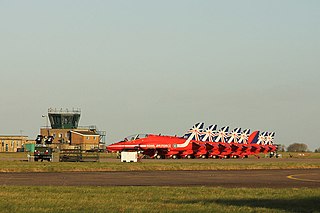
Royal Air Force Scampton or RAF Scampton is a Royal Air Force station located adjacent to the A15 road near to the village of Scampton, Lincolnshire, and 6 miles (9.7 km) north-west of the city of Lincoln, England.

Royal Air Force Coningsby or RAF Coningsby, is a Royal Air Force (RAF) station located 13.7 kilometres (8.5 mi) south-west of Horncastle, and 15.8 kilometres (9.8 mi) north-west of Boston, in the East Lindsey district of Lincolnshire, England. It is a Main Operating Base of the RAF and home to three front-line Eurofighter Typhoon FGR4 units, No. 3 Squadron, No. 11 Squadron and No. 12 Squadron. In support of front-line units, No. 29 Squadron is the Typhoon Operational Conversion Unit and No. 41 Squadron is the Typhoon Test and Evaluation Squadron. Coningsby is also the home of the Battle of Britain Memorial Flight (BBMF) which operates a variety of historic RAF aircraft.

Royal Air Force Finningley or RAF Finningley was a Royal Flying Corps and Royal Air Force station at Finningley, in the Metropolitan Borough of Doncaster, South Yorkshire, England. The station straddled the historic county boundaries of both Nottinghamshire and the West Riding of Yorkshire.

RAF Middleton St George was a Royal Air Force (RAF) and Royal Canadian Air Force (RCAF) Bomber Command station during World War II. It was located in County Durham, five miles east of Darlington, England. The station's motto was Shield and Deter. The aerodrome remains active as Teesside International Airport.

Royal Air Force East Kirkby or more simply RAF East Kirkby is a former Royal Air Force station near the village of East Kirkby, south of Horncastle in Lincolnshire, just off the A155. The airfield is now home to the Lincolnshire Aviation Heritage Centre air museum.

Royal Air Force Hemswell or more simply RAF Hemswell is a former Royal Air Force (RAF) station located 7.8 miles (12.6 km) east of Gainsborough, Lincolnshire, England.
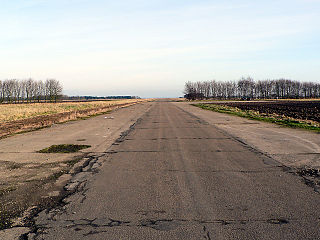
Royal Air Force Metheringham or more simply RAF Metheringham is a former Royal Air Force station situated between the villages of Metheringham and Martin and 12.1 mi (19.5 km) south east of the county town Lincoln, Lincolnshire, England.
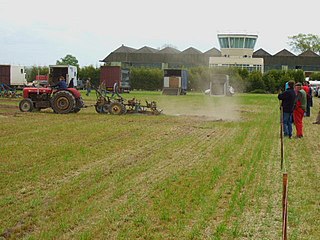
Royal Air Force Station Lindholme or more simply RAF Lindholme is a former Royal Air Force station in South Yorkshire, England. It was located 3.9 miles (6.3 km) south of Thorne and 6.9 miles (11.1 km) north east of Doncaster and was initially called RAF Hatfield Woodhouse.

Royal Air Force Elsham Wolds or more simply RAF Elsham Wolds is a former Royal Air Force station in England, which operated in the First World War and the Second World War. It is located just to the north east of the village of Elsham in north Lincolnshire.

Royal Air Force North Killingholme or more simply RAF North Killingholme is a former Royal Air Force station located immediately west of the village of North Killingholme in North Lincolnshire, England.
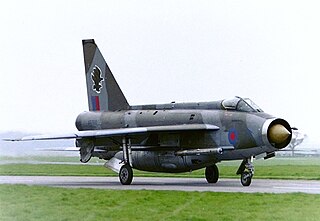
Royal Air Force Binbrook or RAF Binbrook was a Royal Air Force station, now closed, located near Binbrook, Lincolnshire, England. The old domestic site has been renamed to become the village of Brookenby. RAF Binbrook was primarily used by Bomber Command in the Second World War. The Central Fighter Establishment moved to Binbrook from RAF West Raynham between 1959 and 1962 and two English Electric Lightning squadrons were stationed there between 1965 and 1988.
Royal Air Force Wickenby or RAF Wickenby was a purpose-built Royal Air Force station constructed late 1942 and early 1943. It lies halfway between Wickenby and Holton cum Beckering, to the south-east of Wickenby close to the B1399 in West Lindsey, 8 NM north-east of Lincoln, England.
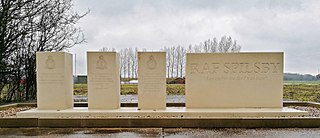
Royal Air Force Spilsby or more simply RAF Spilsby is a former Royal Air Force station during the Second World War and the Cold War located in the rural village of Great Steeping, near the market town of Spilsby, Lincolnshire, England.
Royal Air Force Skellingthorpe or more simply RAF Skellingthorpe is a former Royal Air Force station which was operational during the Second World War. It was located just west of the city of Lincoln, England about 2.5 miles (4 km) south-east of the village of Skellingthorpe on a field previously called Black Moor. After its closure the site was developed as the Birchwood estate.

No. 550 Squadron RAF was a heavy bomber squadron of the Royal Air Force during World War II. Formed at RAF Waltham on 25 November 1943, 550 Squadron flew Avro Lancaster bombers as part of No. 1 Group RAF. In early 1944, the squadron was moved to RAF North Killingholme, Lincolnshire where it continued operations until May 1945, when it began dropping food over the Netherlands as a relief effort as part of Operation Manna. The squadron was disbanded on 31 October 1945. Today, a surviving Lancaster bomber continues to fly in the markings of BQ-B "Phantom of the Ruhr" EE139 from 550 squadron as part of the Battle of Britain Memorial Flight.
Royal Air Force Doncaster or more simply RAF Doncaster, also referred to as Doncaster Aerodrome, is a former Royal Air Force station near Doncaster, South Yorkshire, England.

Royal Air Force Cammeringham or more simply RAF Cammeringham was a Royal Air Force station used by RAF Bomber Command between 1940 and 1945 and the Polish Air Force until 1946. The airfield was located between the A15 and B1398 roads, 10.3 mi (16.6 km) north of the city Lincoln, Lincolnshire, England and due east of the village of Ingham.

RAF Anwick is a former Second World War faux Royal Air Force station near the village of Anwick, 21.3 mi (34.3 km) south east of the county town of Lincoln, Lincolnshire, England. The airfield was located in a field three quarters of a mile north-north-west of Anwick village.
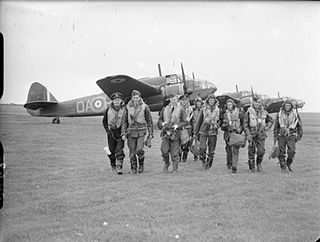
RAF North Coates was a Royal Air Force station in Lincolnshire, England, six miles south-east of Cleethorpes, and close to the mouth of the Humber estuary. It was an active air station during World War I, and then again from the mid-1920s. Between 1942 and 1945, during the Second World War, it was the home of a Coastal Command Strike Wing, and from 1958 was a base for Bloodhound surface-to-air missiles, until closed in 1990.























